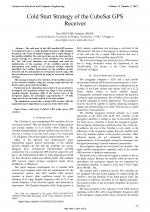| 2/2014 - 5 |
Cold Start Strategy of the CubeSat GPS ReceiverKOVAR, P. |
| View the paper record and citations in |
| Click to see author's profile in |
| Download PDF |
Author keywords
cold start, CubeSat, LEO orbit, space GPS receiver
References keywords
navigation(8), space(7), receiver(6), satellite(4), gnss(4)
Blue keywords are present in both the references section and the paper title.
About this article
Date of Publication: 2014-05-31
Volume 14, Issue 2, Year 2014, On page(s): 29 - 34
ISSN: 1582-7445, e-ISSN: 1844-7600
Digital Object Identifier: 10.4316/AECE.2014.02005
Web of Science Accession Number: 000340868100005
SCOPUS ID: 84901825251
Abstract
The cold start of the LEO satellite GPS receiver is complicated due to a large Doppler frequency shift, Doppler frequency rate of the navigation signals and a rapid change of the satellite visibility. The cold start time can be shortened by a proper strategy of a selection of the satellites to be searched for. The cold start simulator was developed and used for optimization of the sequence of the satellites search, for development and testing of an advanced satellite selection algorithm that utilizes information on the satellites already detected and for optimization of a frequency search range. The best performance was achieved by using an advanced selection strategy. The strategy is based on the selection of the satellites nearest to the detected satellite, using the average angle between the Earth center (apex) and the satellites. Furthermore, the simulation shows that it is not practical to investigate all frequencies within the range of the maximum possible Doppler frequency shift of the carrier wave of the navigation signal, but investigate approximately +/- 35 kHz range and, if not successful, switch to the next satellite. The simulations proved that a simple GPS receiver with the sequential search algorithms can operate in the LEO orbit. |
| References | | | Cited By |
Web of Science® Times Cited: 5 [View]
View record in Web of Science® [View]
View Related Records® [View]
Updated 2 days, 11 hours ago
SCOPUS® Times Cited: 5
View record in SCOPUS® [Free preview]
View citations in SCOPUS® [Free preview]
[1] Experiences with the GPS in Unstabilized CubeSat, Kovar, Pavel, International Journal of Aerospace Engineering, ISSN 1687-5966, Issue , 2020.
Digital Object Identifier: 10.1155/2020/8894984 [CrossRef]
[2] Simulation of Navigation Receiver for Ultra-Small Satellite, Spiridonov, A. A., Ushakov, D. V., Saechnikov, V. A., Devices and Methods of Measurements, ISSN 2414-0473, Issue 4, Volume 10, 2019.
Digital Object Identifier: 10.21122/2220-9506-2019-10-4-331-340 [CrossRef]
[3] Parallel Frequency Acquisition Algorithm for BeiDou Software Receiver Based on Coherent Downsampling, Zeng, Qingxi, Gao, Chang, Qiu, Wenqi, Zhou, Zhaihe, Lyu, Chade, Journal of Navigation, ISSN 0373-4633, Issue 2, Volume 73, 2020.
Digital Object Identifier: 10.1017/S0373463319000699 [CrossRef]
[4] piNAV L1—GPS receiver for small satellites, Kovář, P., Gyroscopy and Navigation, ISSN 2075-1087, Issue 2, Volume 8, 2017.
Digital Object Identifier: 10.1134/S2075108717020079 [CrossRef]
Disclaimer: All information displayed above was retrieved by using remote connections to respective databases. For the best user experience, we update all data by using background processes, and use caches in order to reduce the load on the servers we retrieve the information from. As we have no control on the availability of the database servers and sometimes the Internet connectivity may be affected, we do not guarantee the information is correct or complete. For the most accurate data, please always consult the database sites directly. Some external links require authentication or an institutional subscription.
Web of Science® is a registered trademark of Clarivate Analytics, Scopus® is a registered trademark of Elsevier B.V., other product names, company names, brand names, trademarks and logos are the property of their respective owners.
Faculty of Electrical Engineering and Computer Science
Stefan cel Mare University of Suceava, Romania
All rights reserved: Advances in Electrical and Computer Engineering is a registered trademark of the Stefan cel Mare University of Suceava. No part of this publication may be reproduced, stored in a retrieval system, photocopied, recorded or archived, without the written permission from the Editor. When authors submit their papers for publication, they agree that the copyright for their article be transferred to the Faculty of Electrical Engineering and Computer Science, Stefan cel Mare University of Suceava, Romania, if and only if the articles are accepted for publication. The copyright covers the exclusive rights to reproduce and distribute the article, including reprints and translations.
Permission for other use: The copyright owner's consent does not extend to copying for general distribution, for promotion, for creating new works, or for resale. Specific written permission must be obtained from the Editor for such copying. Direct linking to files hosted on this website is strictly prohibited.
Disclaimer: Whilst every effort is made by the publishers and editorial board to see that no inaccurate or misleading data, opinions or statements appear in this journal, they wish to make it clear that all information and opinions formulated in the articles, as well as linguistic accuracy, are the sole responsibility of the author.





